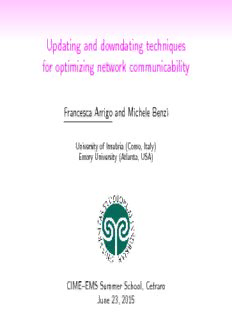
Updating and downdating techniques for optimizing network communicability PDF
Preview Updating and downdating techniques for optimizing network communicability
Updating and downdating techniques for optimizing network communicability Francesca Arrigo and Michele Benzi UniversityofInsubria(Como,Italy) EmoryUniversity(Atlanta,USA) CIME–EMS Summer School, Cetraro June 23, 2015 Complex networks...? A complex network is a graph that exhibits non-trivial topological features. A complex network is not a regular, nor a random graph. ✞ ☎ ✝ ✆ They are used to model interactions of various types: social networks: collaboration, friendship,...; • biological networks: PPI, food webs,...; • technological networks: www, internet,...; • transportation network: air routes, road maps,... • and of course they are used to describe Facebook, Twitter, Instagram, ... • Complex networks...? A complex network is a graph that exhibits non-trivial topological features. A complex network is not a regular, nor a random graph. ✞ ☎ ✝ ✆ They are used to model interactions of various types: social networks: collaboration, friendship,...; • biological networks: PPI, food webs,...; • technological networks: www, internet,...; • transportation network: air routes, road maps,... • and of course they are used to describe Facebook, Twitter, Instagram, ... • Motivation We aim at making (minimal) modifications to an existing network so as to maximize its ability to propagate “information” along its edges. Total communicability (TC): quantifies the ease of spreading information across the network and how well connected a network is. We want to manipulate the ✓ ✏ edgesinthenetwork inorderto tune the TC. ✒ ✑ Background Let G = (W,E) be a complex network with n = W nodes and | | m = E edges. | | Suppose that: G is unweighted; • G has no multiple edges nor self loops; • m = O(n). • Adjacency matrix G can be represented using an adjacency matrix A Rn×n ∈ ω if (i,j) E ij (A)ij = aij = ∈ 0 otherwise (cid:26) where ω R are weights for the elements in E. ij ∈ In our framework A = (a ) Rn×n will be: ij ∈ binary and a = 0 for all i V; ii • ∈ symmetric, if G is undirected; • sparse. • A few useful definitions when AT = A walk of length k: • i ,i ,...,i V (i ,i ) E for all 1 l k 1 2 k+1 l l+1 { ∈ | ∈ ≤ ≤ } closed walk of length k: a walk for which i = i . 1 k+1 • Remark The quantities Ak , Ak count closed (resp., open) walks of ii ij length k. (cid:0) (cid:1) (cid:0) (cid:1) degree of node i: • d = j V : (i,j) E = A2 . i |{ ∈ ∈ }| ii (cid:0) (cid:1) total communicability of an undirected network • TC(A) = 1TeA1 = ∞ 1TAk1 k=0 k! P A few useful definitions when AT = A walk of length k: • i ,i ,...,i V (i ,i ) E for all 1 l k 1 2 k+1 l l+1 { ∈ | ∈ ≤ ≤ } closed walk of length k: a walk for which i = i . 1 k+1 • Remark The quantities Ak , Ak count closed (resp., open) walks of ii ij length k. (cid:0) (cid:1) (cid:0) (cid:1) degree of node i: • d = j V : (i,j) E = A2 . i |{ ∈ ∈ }| ii (cid:0) (cid:1) total communicability of an undirected network • TC(A) = 1TeA1 = ∞ 1TAk1 k=0 k! P Problem setting We develop techniques aimed at tackling the following problems. Downdate: select K edges that can be downdated from the • network that cause the smallest drop in TC(A); Update: select K virtual edges to be added to the network so • as to increase as much as possible the total communicability of the graph; Edges connecting important nodes are themselves important: ✤ ✜ eC(i,j) = C(i) C(j), i,j V · ∀ ∈ where C( ) : V R is a centrality measure for nodes. · → ✣ ✢ Node centrality measures The centrality measures we use are all walk–based: 1. eigenvector centrality: EC(i) = q (i); 1 2. subgraph centrality: ∞ (Ak) SC(i) = (eA) = ii; ii k! k=0 X 3. total communicability: ∞ (Ak1) TC(i) = (eA1) = i. i k! k=0 X
Description: